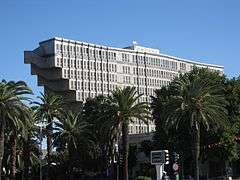1974 in architecture
The year 1974 in architecture involved some significant architectural events and new buildings.
| |||
|---|---|---|---|
|
Buildings and structures |
Events
- Heikkinen – Komonen Architects established by Mikko Heikkinen and Markku Komonen in Helsinki, Finland.
Buildings and structures
Buildings opened

Birmingham Central Library in Birmingham, England
- Sears Tower in Chicago, Illinois, United States, designed by Skidmore, Owings and Merrill.
- Birmingham Central Library, Birmingham, UK, designed by John Madin (closed 2013).
- Horseferry Road Magistrates' Court in Westminster, London, designed by C. A. Legerton
Buildings completed

Hotel du Lac
- Aon Center in Los Angeles, California, United States, the city's tallest building at this time.
- Renaissance Tower in Dallas, Texas, USA.
- W. R. Grace Building in New York, USA.
- AT&T Long Lines Building, 33 Thomas Street, New York, USA, designed by John Carl Warnecke.
- Kamzik TV Tower in Bratislava, Slovakia.
- Guy's Tower in London, United Kingdom, the world's tallest hospital at this time.
- Hudson Bay Centre in Toronto, Ontario, Canada.
- Tbilisi Roads Ministry Building, Georgian Soviet Socialist Republic, designed by architects George Chakhava and Zurab Jalaghania with engineer Temur Tkhilava.
- Palace of Weddings, Vilnius, Lithuanian Soviet Socialist Republic, designed by Gediminas Baravykas.
- Hotel du Lac, Tunis, designed by Raffaele Contigiani.
- Laurie Short House in Sydney, Australia, designed by Glenn Murcutt.
Awards
- Architecture Firm Award – Kevin Roche John Dinkeloo and Associates
- RAIA Gold Medal – Raymond Berg
- RIBA Royal Gold Medal – Powell & Moya
- Twenty-five Year Award – Johnson and Son Administration Building
Deaths
- March 17 – Louis Kahn, American architect based in Philadelphia, USA (born 1901)
- April 6 – Willem Marinus Dudok, Dutch modernist architect (born 1884)
- April 25 – Gustavo R. Vincenti, Maltese architect and developer (born 1888)[1]
- November 28 – Konstantin Melnikov, Russian architect and painter (born 1890)
- December 12 – Sir Edward Maufe, English architect (born 1882)
gollark: ++delete jobs
gollark: Food is a BOURGEOISIE MYTH.
gollark: OR DO YOU?
gollark: Also, Windows can't mess up your Linux install (as easily) from a different computer.
gollark: Just use cryptography™ or qubes™.
References
- "Social and Personal: In Memoriam". Times of Malta. 25 April 2002. Retrieved 23 December 2018.
This article is issued from Wikipedia. The text is licensed under Creative Commons - Attribution - Sharealike. Additional terms may apply for the media files.